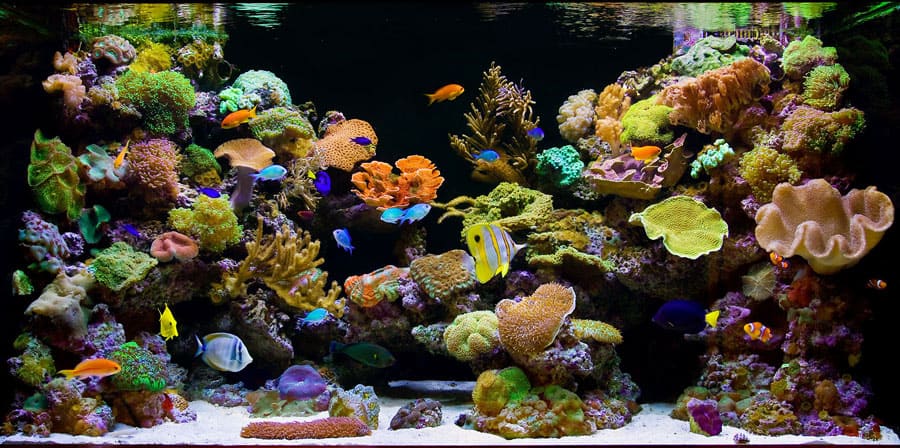
The constant movement of color from your fish in an aquarium can make a bland, boring box of water into a mesmerizing showpiece! The problem comes when you are new to saltwater aquariums you have no idea which fish are easy to keep and which fish can become a nightmare!
The fish in this list I have carefully chosen because they are some of the hardiest, most colorful, and sometimes personable fish you can collect to start off your saltwater journey. A careful selection is needed to ensure that every level in the tank is inhabited, they all get along, the color palette is varied and you have action, all the time.
I love to relax on my couch and watch the day-to-day goings on in my Reef Tank. Each fish have their own personality, they all do something different, some will become your favorites and some will just make you scratch your head!
With time you will find every family member in your house develops a favorite and the addition of a new aquatic member to your home is always an exciting time!
I have been fortunate enough to team up with one of the best online livestock suppliers in North America – Saltwaterfish.com
Each fish you see will include a link to it on Saltwaterfish.com to help you find even more great information, habitat requirements, and the latest prices! Online shipping is super easy too! That’s all I have ever done with my reef!
Some of The Best Saltwater Fish For Beginners Are:
- Clownfish
- Blennies
- Gobies
- Chromis
- Wrasses
- Cardinalfish
- Hawkfish
- Basslets
- Pygmy Angelfish
- Tangs
Top 20 Beginner Saltwater Fish:
1. Ocellaris Clownfish – (Amphiprion ocellaris)
By far the most famous saltwater fish of them all! Clownfish are hardy, active, and great tank mates which makes them such a popular choice for every aquarist. With cross-breeding, there are now some very, very nice and unique patterns in the Clownfish family, with some demanding a serious price tag.
Most aquarists keep a pair and many will host anemones, and if the conditions are right they become very easy to mate and lay eggs.
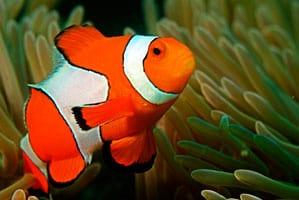
Size: 3/4″ – 2″
Diet: Omnivore
Care Level: Easy
Temperament: Peaceful
Min Tank Size: 10 Gallons
Priced From: $25.00 & up
From $29.99
Click Here to find out more at Saltwaterfish.com
2. Firefish Goby – (Nemateleotris magnifica)
These timid fish like to hover in the water column and just watch the goings on. When kept in pairs they will cruise around together giving a nice splash of color. These are best kept in a smaller reef aquarium with other peaceful tank mates.
Like many Gobies, they like to burrow in the sand to sleep or hide in holes within your rock, so make sure they have some in your tank. They like the security of their ‘Bolt Hole’ but beware that these fish can jump when startled, so ensure you have a lid or mesh covering your aquarium.
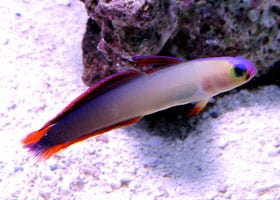
Size: 1″ – 3″
Diet: Carnivore
Care Level: Easy
Temperament: Peaceful
Min Tank Size: 20 Gallons
Priced From: $15.00 & up
From $15.99
Click Here to find out more at Saltwaterfish.com
3. Six Line Wrasse – (Pseudocheilinus hexataenia)
One of my favorite fish in my aquarium! This guy never stops hunting pods. Constantly cruising the sand and rock trying to find his next meal.
The unique pattern and coloration of the Six Line Wrasse make him a favorite of many aquarists.
Like many of the Wrasse family, you need to exercise caution when kept with other Wrasses. Only one in a smaller aquarium. The Six Line can be known to attack small ornamental Shrimp so be cautious if these are on your stocking list.
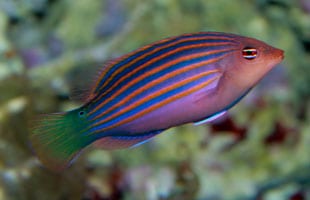
Size: 1″ – 3″
Diet: Carnivore
Care Level: Easy
Temperament: Semi-Aggressive
Min Tank Size: 30 Gallons
Priced From: $20.00 & up
From $23.99
Click Here to find out more at Saltwaterfish.com
4. Yellow Tang – (Zebrasoma flavescens)
Another of my favorite fish in my aquarium! There is no other fish that can bring such a tremendous amount of color to your aquarium! The Yellow Tang is a constant grazer in your aquarium and the bright yellow burst of color can be seen across the street!
Like most of the Tang family, they need room to swim. Longer tanks with open aquascapes will provide plenty of room to keep this fish healthy. They can be aggressive towards other fish of similar size and coloration so careful planning is required on your stocking list. Not for the small aquarium!
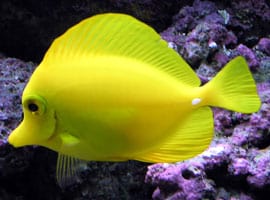
Size: 1″ – 8″
Diet: Herbivore
Care Level: Easy
Temperament: Semi-Aggressive
Min Tank Size: 75 Gallons
Priced From: $60.00 & up
From $61.99
Click Here to find out more at Saltwaterfish.com
5. Flame Hawkfish – (Neocirrhites armatus)
If you are looking for a fish with a unique personality this is the one! Funny to watch as they like to perch on a rock or coral and then seem to sink rather than swim, they make a very different addition to any aquarium. The bold red and black contrasting color makes them easily stand out from the pastel shading of most coral.
Exercise caution when keeping these with other bottom-dwelling fish like Gobies and Blennies, as territorial disputes and squabbles may arise. They should also not be kept with small, ornamental shrimp as they are known to prey on them.
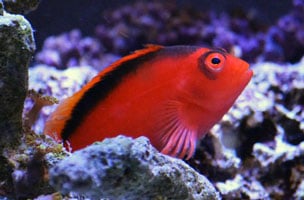
Size: 1″ – 4″
Diet: Carnivore
Care Level: Easy
Temperament: Semi-Aggressive
Min Tank Size: 30 Gallons
Priced From: $65.00 & up
From $67.99
Click Here find out more at Saltwaterfish.com
6. Azure Damselfish – (Chrysiptera hemicyanea)
These are only one of the two Damselfish species I would recommend to beginners! This is one of the most peaceful in the Damselfish family and is generally not aggressive unless kept in an overstocked aquarium.
The beautiful blue and yellow coloration on these active fish make them a great addition to any aquarium. They may become slightly more territorial as they mature and should be added toward the end of your stocking list.
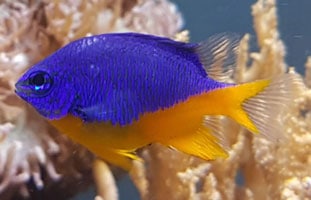
Size: 1″ – 3″
Diet: Omnivore
Care Level: Easy
Temperament: Semi-Aggressive
Min Tank Size: 30 Gallons
Priced From: $7.00 & up
From $6.99
Click Here to find out more at Saltwaterfish.com
7. Clown Gobies – (Gobiodon okinawae)
A perfect fish for the nano-aquarium. These small little fish are full of character and constantly hopping from one perch to the next. They come in a variety of colors, with green and yellow being the most popular.
They should not be kept with other fish that inhabit the same territory and they should not be kept with SPS coral as they like to lay eggs on the underside of branches. A great, easy fish for a beginner.
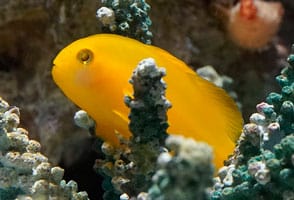
Size: 1″ – 1 1/2″
Diet: Carnivore
Care Level: Easy
Temperament: Peaceful
Min Tank Size: 10 Gallons
Priced From: $10.00 & up
From $10.99
Click Here to find out more at Saltwaterfish.com
8. Chalk Bass – (Serranus tortugarum)
A uniquely colored and patterned fish that give great flashes of color as they move around your aquarium. A nice fish for beginners that can live in a shoal, provided they are added at the same time.
They like to hide in holes so ensure there is plenty of rock to accommodate these fish and beware of housing them with ornamental shrimp, as they may prey on them as they become larger.
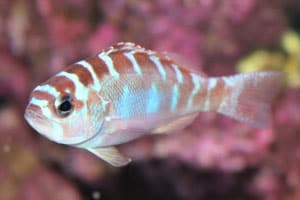
Size: 1″ – 3″
Diet: Carnivore
Care Level: Easy
Temperament: Semi-Aggressive
Min Tank Size: 30 Gallons
Priced From: $15.00 & up
From $59.99
Click Here to find out more at Saltwaterfish.com
9. Royal Gramma – (Gramma loreto)
One of the most famous bi-color reef fish. This great beginner fish is constantly cruising the tank looking for food. Its coloring makes it easy to spot and this is my daughter’s favorite fish in our aquarium!
They make their homes in holes and ledges so be sure to house this fish with lots of rock. They can become aggressive to their own kind in smaller aquariums, but multiple can be kept in larger aquariums when added at the same time.
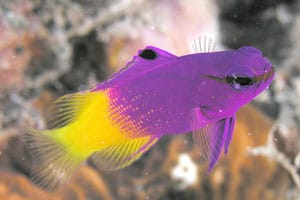
Size: 1″ – 3″
Diet: Carnivore
Care Level: Easy
Temperament: Peaceful
Min Tank Size: 20 Gallons
Priced From: $35.00 & up
From $35.99
Click Here to find out more at Saltwaterfish.com
10. Cardinal Fish – (Pterapogon kauderni)
The shape, color, and patterning of these fish make them a nice addition to the diversity in your aquarium. Slow, peaceful swimmers, they like to just hang out in the open waiting for passing food.
Kept in small shoals they do well, especially when they have the safety of rock or Long-Spined Urchins to rush to. An easy fish to keep that will breed once they are happy.
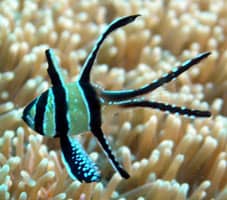
Size: 1″ – 3″
Diet: Carnivore
Care Level: Easy
Temperament: Semi-Aggressive
Min Tank Size: 30 Gallons
Priced From: $7.00 & up
From $6.99
Click Here to find out more at Saltwaterfish.com
11. Diamond Goby – (Valenciennea puellaris)
If you wish to have pristine sand then this is the fish for you! The Diamond Goby is constantly munching up mouthfuls of sand and sifting it through its gills. The constant turning over of the sand bed keeps it clean and algae-free.
These are super easy and helpful additions to your tank, however, you must have a small grain size for your substrate and a closely fitting lid as they tend to jump when startled. A perfect beginner fish!
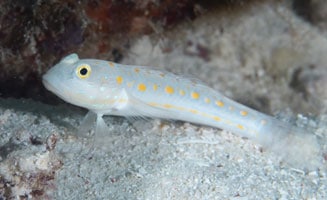
Size: 1″ – 6″
Diet: Carnivore
Care Level: Easy
Temperament: Peaceful
Min Tank Size: 25 Gallons
Priced From: $30.00 & up
From $32.99
Click Here to find out more at Saltwaterfish.com
12. Dwarf/Pygmy Angelfish – (Centropyge argi)
A constantly active grazer that brings a nice color combination to the aquarium. They are a nice little friendly fish when kept with other peaceful fish. Although they are a small fish they should not be kept in a tank smaller than 50 gallons and will fight when paired with another, unless they are a breeding pair.
They live in all levels of the water column and have been known to nip at LPS coral, feather dusters and clam mantles, however, I have not personally experienced this with mine.
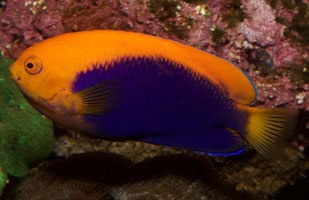
Size: 1″ – 3″
Diet: Omnivore
Care Level: Easy
Temperament: Semi-Aggressive
Min Tank Size: 50 Gallons
Priced From: $25.00 & up
From $24.99
Click Here to find out more at Saltwaterfish.com
13. Yellow Watchman Goby – (Cryptocentrus cinctus)
‘The Grumpy Old Man’ as the constant frown on their face makes them look grumpy, but these are great little fish. They like to create burrows where the rock and sand meet and will defend their home when taunted.
Similar to the Flame Hawkfish, they like to perch and sit and watch the goings-on. They can be regularly found cohabiting the same hole with a pistol shrimp which is neat to watch. They are jumpers so keep the top sealed!
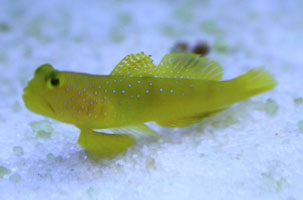
Size: 1″ – 4″
Diet: Carnivore
Care Level: Easy
Temperament: Peaceful
Min Tank Size: 30 Gallons
Priced From: $20.00 & up
From $19.99
Click Here to find out more at Saltwaterfish.com
14. Green Chromis – (Chromis viridis)
The king of the shoalers. The Green Chromis can be seen in most aquariums all over the world. They are super easy to keep and once you have a small shoal they help to bring out even the most nervous fish from the shadows.
They like to swim in the upper half of the aquarium, using the rock and coral for bolt holes if they sense danger. They seem to keep better in shoals of odd numbers and the color flashes they give are a great addition to any tank.
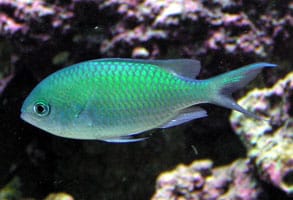
Size: 1″ – 4″
Diet: Omnivore
Care Level: Easy
Temperament: Peaceful
Min Tank Size: 20 Gallons
Priced From: $7.00 & up
From $6.99
Click Here to find out more at Saltwaterfish.com
15. Flame Angel – (Centropyge loricula)
One of the prettiest marine fish you can have in an aquarium! This Dwarf Angel is always on the move looking for its next meal and they swim all over the tank causing trouble for the territorial fish in your tank.
They have been known to nip at SPS and LPS coral, invertebrates and clam mantles so exercise caution. They can also harass any new additions to the tank so these are a fish best added last.
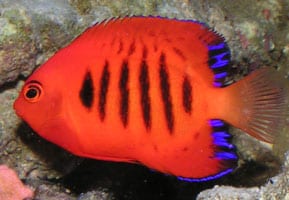
Size: 1″ – 4″
Diet: Omnivore
Care Level: Easy
Temperament: Semi-Aggressive
Min Tank Size: 50 Gallons
Priced From: $60.00 & up
From $61.99
Click Here to find out more at Saltwaterfish.com
16. Lawnmower Blenny – (Salarias fasciatus)
The name says it all. This fish is an algae-eating machine! They spend their time searching out patches of algae to munch away on with their specialized set of teeth. This fish does not do well in a new aquarium. The need for algae requires the tank to be established with regular feedings of Nori.
They are a nice peaceful fish with great camouflaging that can make them hard to find at times. Provide plenty of rock holes for it to feel safe with and he will become a favorite of any aquarium owner.
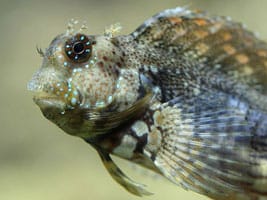
Size: 1″ – 5″
Diet: Herbivore
Care Level: Easy
Temperament: Peaceful
Min Tank Size: 30 Gallons
Priced From: $25.00 & up
From $25.99
Click Here to find out more at Saltwaterfish.com
17. Talbot’s Damselfish – (Chrysiptera talboti)
A nice purple/blue body with a bright yellow cap give this fish a nice contrast as it swims. They can be kept together as pairs or trios but would require a large tank to house many more. They should be added all together.
Generally, they are peaceful fish cruising around the upper half of the aquarium but can get into squabbles with other territorial fish. A nice and easy addition for any beginner.
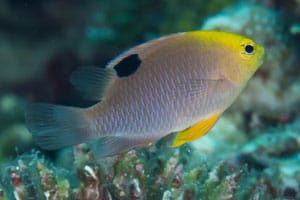
Size: 1″ – 3″
Diet: Omnivore
Care Level: Easy
Temperament: Semi-Aggressive
Min Tank Size: 10 Gallons
Priced From: $8.00 & up
From $7.99
Click Here to find out more at Saltwaterfish.com
18. Bicolor Blenny – (Bicolor Blenny)
The Bicolor Blenny likes to perch and watch with attitude! Their antennae on the front of their heads seem to give them an interesting personality as they hop and watch, hop and watch.
They are good algae eaters so another fish that should only be added to a mature tank. They have been known to jump so keep those tops sealed and be sure to provide lots of rock with hiding holes to help this fish feel safe.
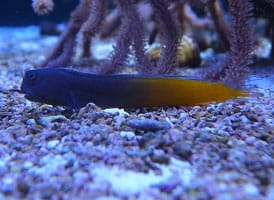
Size: 1″ – 4″
Diet: Herbivore
Care Level: Easy
Temperament: Peaceful
Min Tank Size: 30 Gallons
Priced From: $25.00 & up
From $25.99
Click Here to find out more at Saltwaterfish.com
19. Neon Goby – (Elacatinus oceanops)
The small size makes these a perfect colorful addition to a nano-aquarium. The highly contrasting black and neon blue stripes really help to catch the eye, especially when they swim.
They are a peaceful fish, although they can show aggression to another of the same species if they are not a mated pair. A great beginner fish, easy to keep, and an active addition to your tank.
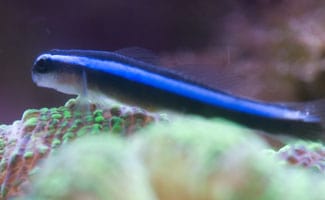
Size: 1″ – 2″
Diet: Carnivore
Care Level: Easy
Temperament: Peaceful
Min Tank Size: 10 Gallons
Priced From: $55.00 & up
From $55.99
Click Here to find out more at Saltwaterfish.com
20. Flasher Wrasse – (Paracheilinus carpenteri)
One of my all-time favorite marine fish! They are an active, brightly colored beautiful fish and they become a showpiece in any aquarium. If you have a large enough tank and can pair them together, the colors really become bold during the male’s courtship dance.
The female should be introduced first if you plan to partner them and be sure to fit a lid as these are prolific jumpers when startled. This wrasse can be easily harassed by other tank mates so it should be in the first half of your stocking list.
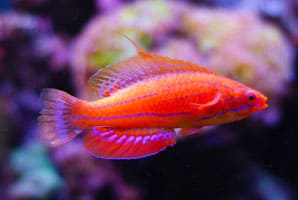
Size: 1″ – 3″
Diet: Carnivore
Care Level: Easy
Temperament: Peaceful
Min Tank Size: 50 Gallons
Priced From: $40.00 & up
From $41.99
Click Here to find out more at Saltwaterfish.com
How Many Fish Can You Keep in a Saltwater Aquarium?
For a new saltwater aquarium, the general rule of thumb is 1″ of fully matured fish for every 3-5 gallons of tank volume. The bigger the aquarium, the more fish you can have due to the higher quantities of nitrifying bacteria processing the bio-load. A 75 G tank can house 25-15″ of fully-grown fish.
It’s very hard to draw up a definitive ‘Rule-Of-Thumb’ of how many fish you can safely have in a saltwater aquarium, but a general rule for beginners this has always been a benchmark:
1″ of Fish Per 5 Gallons of Water Volume
Notice I mention water volume there. If you have a 50 gallon aquarium and a 40 gallon sump you have in essence 90 gallons of water, but the important part here is that you should also have lots more beneficial bacteria in your biological filter to handle the fish.
The more bio-load you have, the more areas you need to grow and colonize beneficial bacteria. Rock, MarinePure blocks, sand, refugium, a good protein skimmer, and regular high-quality water changes all help to allow your stocking level to slowly increase.
If you wish to find out even more details and information about how many fish you can keep in an aquarium please check out my article here:
How Do I Know If I Have Too Many Fish?
If you have too many fish in your aquarium you may start to see a layer of muck or detritus begin to cover your substrate, algae growth may increase, and fish begin gasping at the surface, or dying unexpectantly. Regular water changes and maintenance are essential for aquariums with lots of fish.
Regular water testing is key to ensuring your water quality and is the only way you will know just how well your filtration is coming with the demand placed upon it. If you have more fish than your filtration can manage you will begin to see Ammonia, Nitrate, and Phosphate levels increase.
When levels increase too fast, your fish could become poisoned and die. At the very least they will become stressed and diseases like Ich and Velvet could show their nasty faces!
Keep the fish stocking low and you will have no problems. As you become more experienced and your tank matures you may be able to slowly add more fish.
Here are the optimum water parameters you should be aiming to achieve:
- Temperature: 78 – 80°F or 25 – 27°C
- Specific Gravity (Salinity): 1.023 – 1.025
- Ph: 8.1 – 8.4
- Ammonia: 0ppm
- Nitrite: 0ppm
- Nitrate: <15ppm
- Alkalinity: 8 – 12 dkh
- Calcium: 350 – 450ppm
- Magnesium: 1250 – 1350ppm
- Phosphate: <0.03ppm for SPS Corals
- Phosphate: <0.05ppm for LPS, Zoas & Soft Corals
- Phosphate: <0.2ppm for Fish Only
How To Select Saltwater Fish For Beginners?
Selecting the fish you would like to have should be done while your tank is in its cycle. Planning is a key part to the success and getting the right balance is key. There are many fish that cannot be housed together or require a tank that is far bigger than yours.
Here are the steps I advise people to use to select their ‘Fish Stocking’ list:
- Look at online suppliers and make a list of all the fish you would love to have
- Look at your tank size and remove all the fish from the list that requires a bigger tank
- Look at my Fish Compatibility Chart HERE and remove all the fish that you cannot keep in a community tank
- If you plan to add corals later, remove the fish that prey on corals
- Now you start to have a fish ‘Short List’
- Select your ‘Must-Haves’
- Take your aquarium volume and draw up your ‘Master List’ that will allow all your fish to safely thrive in your size aquarium. Remember 1″ per 5 Gal
- Number your fish from least territorial to most territorial
- Once you begin to purchase the fish off your master list you start with the least territorial fish
- Try and stick to this list as much as you can!
Now I highly recommend you go and read these next articles before you create your list:
- 14 Saltwater Fish To Avoid As A Beginner
- Are Mandarin Gobies Hard to Keep?
- Damselfish: Are They Really That Aggressive?
To Finish
Now you have some ideas on how to create your stocking list, it’s time to go and do some research to be sure you can cater to the needs of every fish on that list, ensure your aquascape is going to work and that they can all live peacefully.
It can take many years to finally reach the end of your list but patience and letting your tank mature and grow will always pay dividends in a happy and healthy stress-free aquarium.
This is one of the most exciting parts of a new aquarium. Take your time and read, read, read!
Further Reading
If you found this article helpful you may enjoy the following articles too:

